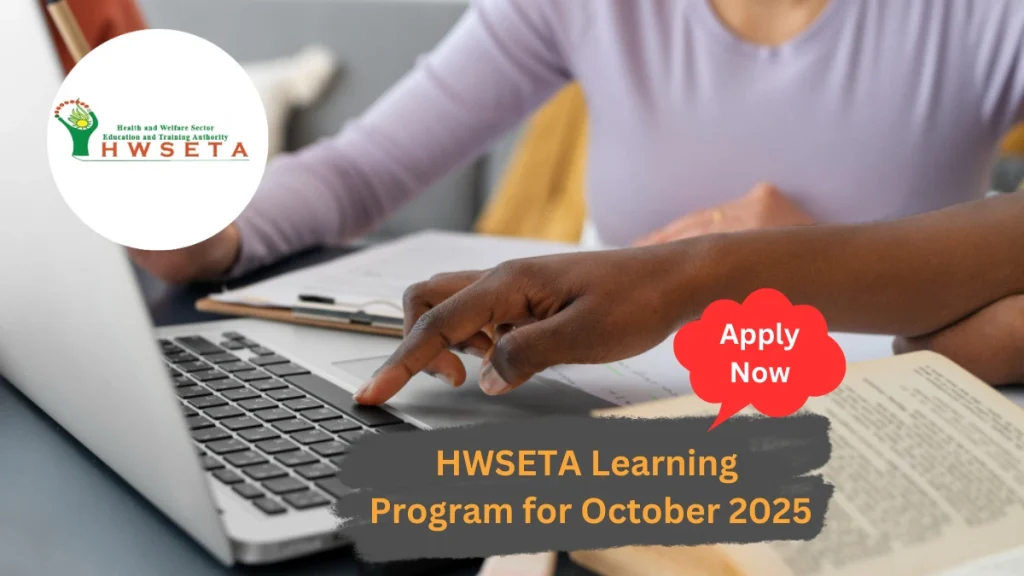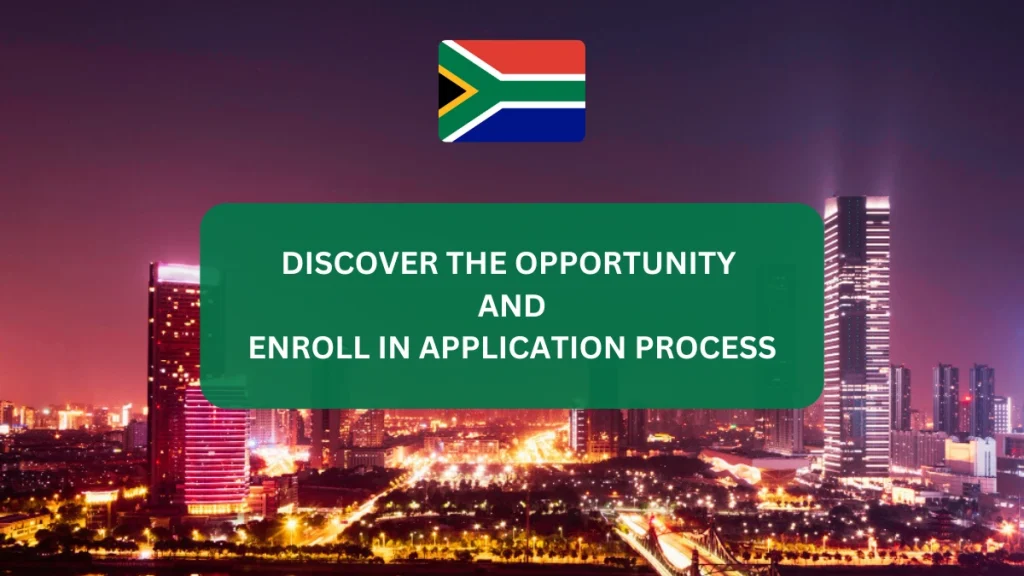Meta description: Discover the HWSETA Learning Program for October 2025. Open to South Africans aged 18–35 with Grade 12, this opportunity offers training, work experience, and a R4800 monthly stipend.
Introduction: A Stepping Stone Into South Africa’s Health and Welfare Sector
South Africa’s health and welfare sector plays a vital role in ensuring the well-being of millions of people. However, the industry constantly needs fresh, skilled professionals to meet growing demands. The Health and Welfare Sector Education and Training Authority (HWSETA) bridges this gap by creating training and learning opportunities that prepare young people for meaningful careers.
One of its flagship initiatives, the HWSETA Learning Program for October 2025, provides young South Africans with practical training, financial support, and valuable work experience. Not only does it help participants enter the workforce, but it also contributes to strengthening the country’s healthcare and social service systems.
If you are between 18 and 35, have completed Grade 12, and are passionate about building a future in health and social development, this program could be your gateway. Even better, it comes with a monthly stipend of R4800 to support you while you learn.
This article explores every detail: eligibility, benefits, application process, and tips to succeed.
What is HWSETA?
The Health and Welfare Sector Education and Training Authority (HWSETA) is one of South Africa’s 21 SETAs (Sector Education and Training Authorities). It operates under the Skills Development Act with a clear mandate: to ensure that the health and welfare industries have a steady pipeline of skilled workers.
Its core functions include:
- Developing qualifications and learning programmes tailored for the health and social services fields.
- Accrediting training providers to ensure quality and compliance.
- Supporting learners financially, often through stipends, bursaries, and grants.
- Driving transformation by opening opportunities for young South Africans, especially those from disadvantaged backgrounds.
- Creating employment pathways by linking education with workplace opportunities.
Through initiatives like the October 2025 Learning Program, HWSETA doesn’t just train individuals—it builds a stronger health and welfare system for the country.
Program Overview: October 2025 HWSETA Learning Program
The October 2025 intake is designed to help participants gain both theoretical knowledge and real-world experience. Instead of being purely academic, the program focuses on practical skills that are directly applicable in health and welfare careers.
Useful Links:
- Youth Opportunities
- Online courses
- Learnerships Programme
- Skills Training Programme
- Funding Bursaries
Objectives of the Program
- Provide young South Africans with entry-level skills needed in hospitals, clinics, community centres, and welfare organisations.
- Create a bridge between education and employment, ensuring that participants are work-ready.
- Empower learners with both technical abilities and soft skills like communication, teamwork, and problem-solving.
- Build a talent pipeline for one of the country’s most essential sectors.
Key Features
- Duration: Typically 12 months (though this may vary by placement).
- Stipend: R4800 per month, easing financial pressure during training.
- Placement: Participants will often be hosted in real workplaces within the health and welfare sector.
- Certification: On completion, learners receive an accredited qualification or certificate of competence.
Why Choose the HWSETA Learning Program?
1. Financial Support: The R4800 Stipend
For many young South Africans, financial barriers are the biggest challenge to further education or training. The R4800 monthly stipend is a game-changer. It allows learners to cover transport, food, and daily living expenses while focusing on gaining new skills.
2. Hands-On Experience
Unlike purely academic courses, this program places learners in real work environments. For example, you might be assisting in a community health project, shadowing a clinic administrator, or supporting welfare initiatives. This practical exposure makes you more employable.
3. Career Readiness
Employers often seek candidates with experience. Through this program, you can confidently enter the job market with both knowledge and on-the-job training. Your CV immediately becomes more competitive.
4. Networking Opportunities
During your placement, you’ll interact with professionals already working in health and social services. These networks can open doors to future employment or mentorship opportunities.
5. Contribution to Society
Choosing a career in health and welfare means more than earning a salary—it’s about improving lives. This program allows you to make a difference in your community while building your career.
Eligibility Criteria: Who Can Apply?
The program is open but selective, focusing on young South Africans with the potential to succeed in the health and welfare sectors.
Age and Education
- Applicants must be between 18 and 35 years old.
- A Grade 12 / Matric certificate (or equivalent qualification) is required.
Language Skills
- Good proficiency in English is essential. Since the program involves workplace interaction, clear communication with colleagues, patients, or clients is vital.
Other Requirements
- Proof of South African citizenship (e.g., a valid ID).
- A CV that highlights education, volunteer work, or relevant experience.
- Willingness to commit to the full duration of the program.
The Application Process: Step by Step
Applying successfully requires preparation. Here’s a guide to help you submit a strong application:
Step 1: Watch for Official Announcements
The HWSETA will publish official calls for applications, usually on its website or through accredited training providers.
Step 2: Gather Your Documentation
Typically required documents include:
- Certified copy of South African ID.
- Matric certificate or proof of equivalent qualification.
- APPLICATION PROCESS
- Curriculum Vitae (CV).
- Any additional documents specified in the official advert.
Step 3: Craft a Strong Application
When completing forms or writing a cover letter:
- Highlight your motivation for joining the health and welfare sector.
- Show any relevant experience, such as volunteering at a clinic, tutoring, or community service.
- Keep your application neat, professional, and error-free.
Step 4: Submit Before the Deadline
Late applications are rarely considered. Aim to apply early to avoid last-minute issues.
Step 5: Prepare for Assessments or Interviews
Shortlisted candidates may be asked to attend interviews or competency tests. Approach these with confidence and preparation.

Maximising Your Success in the Program
Demonstrate Commitment
Employers and mentors want to work with motivated learners. Show your enthusiasm by being punctual, reliable, and proactive.
Build Soft Skills
Technical skills are essential, but soft skills like empathy, problem-solving, and teamwork are equally valued in health and welfare careers.
Embrace Continuous Learning
Ask questions, take notes, and seek feedback during your training. The more you learn, the more valuable you become.
Network Intentionally
Engage with supervisors and colleagues. Build relationships that may lead to job opportunities after the program ends.
Real-World Impact of HWSETA Programs
Over the years, HWSETA programs have transformed lives. Many past participants have gone on to secure stable employment in clinics, hospitals, NGOs, and government departments. Others have used the experience as a stepping stone to further studies in nursing, social work, or health administration.
For instance, a graduate who joined the program in 2023 reported that the hands-on experience at a local welfare organisation gave her both the confidence and the references needed to secure a permanent job. Stories like this highlight the life-changing potential of HWSETA opportunities.
Conclusion: Your Gateway to a Fulfilling Career
The HWSETA Learning Program for October 2025 is more than just training—it’s an investment in your future. With a monthly stipend of R4800, practical workplace experience, and the chance to contribute to South Africa’s health and welfare sector, it offers young people a unique opportunity to succeed.
If you are between 18 and 35, have completed Grade 12, and want to make a real impact, this is your chance. Prepare your documents, watch for application dates, and put your best foot forward.
Your journey into a rewarding and impactful career begins here.
✅ Key Takeaways:
- Program open to South Africans aged 18–35 with Grade 12.
- Offers a R4800 monthly stipend.
- Provides practical work experience in health and welfare.
- Builds both technical and soft skills for career readiness.
- Applications open in October 2025—don’t miss the deadline.

